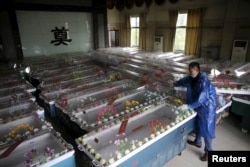Scores of people in central China broke through a police barricade late Wednesday on the Yangtze River at the site of a capsized passenger ship, demanding information on missing relatives.
The confrontation occurred as a small army of divers and other rescue personnel searched frantically for more than 400 passengers missing since Monday night, when the Eastern Star overturned in severe weather.
Chinese authorities said only 14 people had been rescued and 26 bodies recovered, in what is likely to be certified as the worst shipping disaster in modern Chinese history.
A Reuters report said some 80 family members awaiting news in Nanjing, in Jiangsu province, hired a bus for an eight-hour journey to the disaster site in Hubei province, where they confronted police. Early Thursday, a local Jiangsu provincial police official promised they could see the disaster site during the daylight.
Rescue efforts have been complicated by heavy winds and rain, as well as strong currents that have pushed the capsized, shallow-draft vessel nearly three kilometers downstream from the accident site.
Premier coordinates efforts
Chinese Premier Li Keqiang is coordinating rescue efforts at the disaster site — the scene of nearly 50 rescue vessels, 3,000 troops and nearly 200 divers.
Officials said poor visibility underwater and persistent rains continued to make the rescue effort challenging. Inside the 76.5-meter (250-foot) ship, divers reported that many doors were obstructed by wreckage, frustrating search efforts.
Despite this, authorities said they were still determined to find survivors.
Transportation Ministry spokesman Xu Chengguang said that because there was a sliver of hope of finding passengers, officials would continue to focus on rescue-and-recovery efforts.
The ship’s captain and chief engineer are among the survivors, and the two are currently in police custody.
It was not immediately clear if they had provided any new details regarding the possible cause of the accident. Both the captain and chief engineer said a tornado capsized the vessel.
At a briefing on the accident Wednesday, Wuhan meteorological station chief Wu Cuihong said a review of weather data confirmed that a tornado had occurred near the accident site late Monday. Wu said the tornado lasted about 15 to 20 minutes and had winds of more than 118 kph.
Wu and others who spoke with reporters Wednesday did not take questions. It was not immediately clear why, if the storm lasted that long, there were not other reports of significant damage.
Meanwhile, Ministry of Transportation spokesperson Zhong Shoudao said Wednesday that the ship was designed to navigate inland waterways.
"The river ships tend to have a lower standard on wind resistance and wave resistance than ocean ships,'' he said. "If the force of the blowing wind was more than the ship could withstand, then it would have capsized."
Elderly passengers
Most of the passengers aboard the Eastern Star were between the ages of 60 and 80.
According to Chinese state media accounts from survivors, the ship capsized in about two minutes, giving passengers very little time to react.
The Eastern Star ferry was built more than 20 years ago and, according to the Communist Party’s People’s Daily, it passed inspections by authorities in Chongqing last month.
But according to documents on the website of the Nanjing Maritime Safety Administration, the Eastern Star was investigated in 2013 during a safety campaign, Reuters reported. The report gave no details about the nature of the problems but said the defects were reported to Chongqing maritime officials.
VOA's William Ide contributed to this report.











